At No 10 Village, West Coast Berbice, the atmosphere was peaceful, save for the sound of vehicles slowing to access the bypass that was built to facilitate the construction of a concrete bridge. Huge machines were parked nearby as workers rested under a makeshift shed during their lunch break. This was at the end of No 9 Village and the beginning of No 10 from the eastern side.
In the small farming community, almost every home has a kitchen garden. Most of the residents also own livestock, which they take to the seaside to graze. The main occupation is livestock and cash crop farming, although some residents work at the Blairmont Estate, and a few others as minibus drivers.
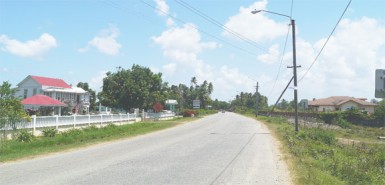
The village has a contractor who builds beautiful houses, a headmistress and former nurses. The only business place is a gas station.
One section of the small village is actually a private estate referred to as ‘Joesy’ and owned by the Isaacs and the Jaundoos, two families who are related through marriage. Magnel Isaacs, 77, told Stabroek News that her father-in-law bought the coconut estate from another resident. Her husband, Samuel Isaacs later inherited a large portion of the estate.
She recalled that they owned a one-bedroom house and she used to get up at 4 am, and along with two other women she would go and catch shrimp in a nearby trench. She would prepare her children’s breakfast before leaving and when she got back she would serve them and send them off to school. Magnel would then walk almost two miles to take her husband’s lunch to the backdam where he planted rice. The woman also fetched home bundles of wood on her head to use in her fireside.
Now that she is unable to go into the estate, persons are stealing a lot of the nuts and she is not benefiting, although she still has to pay the rates and taxes.
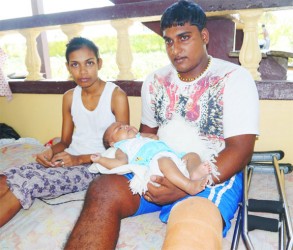
She suffers pain in her knees and shoulders but is otherwise in good health and assists her daughter with chores around the house.
She said that not so long ago when she was “stronger,” she used to accompany her workers to the backdam to pick coconuts. She sold the nuts to wholesalers who used it to make oil and copra. She and her husband also made coconut oil and copra to sell. Now she only makes a little oil for personal use.
A Jaundoo who remains in the village is engaged in large-scale rice farming.
Magnel’s grandson-in-law, Rashleigh ‘Brother’ Wilson who resides next door with his wife, Sharda, came over when this newspaper arrived. The couple does farming around their yard and in Magnel’s yard as well. Wilson also worked a little with the bridge project, laying
bricks for the bypass and then “on the road maintenance.”
Magnel’s daughter, Bernice Shivlall who lives closer to the roadside was busy doing laundry in her yard but was still very accommodating to this newspaper. She also assists her husband farming in their yard. He supplements their income by working at the Blairmont Estate as a
labourer.
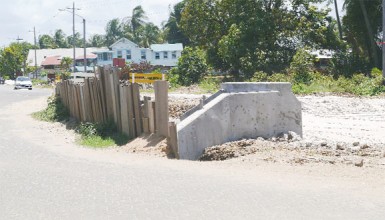
Bernice’s daughter, Regina Dookharan who migrated to Suriname 11 years ago after she got married, was visiting at the time with her three young children. She enjoys living in Suriname but looks forward to visiting Guyana often to spend time with her parents and other relatives.
The biggest problem for her and the children since she came is the constant blackouts. She said it was difficult for them to sleep without the fan at nights.
Regina said vehicles are very cheap in Suriname because the duty is not as high as in Guyana.
She said almost every home can acquire more than one vehicle, “but that results in major traffic jams. When the street lights cannot control the traffic, the police have to do the job.”
Never a dull moment
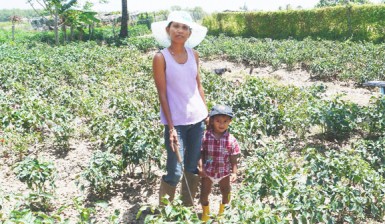
There is never a dull moment for another resident, Carol Nurse, who has been living in the village all her life and serves as a voluntary social worker. She is also a member of the Local Board of Guardians in Region Five, which requires her to “look after old age pension and public assistance. There are times when I would be out in the fields taking certain information.”
She is also the Secretary of the West Berbice Cricket Association and the Achievers Youth & Sports Club. Carol also held the positions of Councillor with the Regional Democratic Council, Overseer with the Bel Air Woodlands Neighbourhood Democratic Council and Assistant Secretary of the Berbice Cricket Board.
Two of her four children are grown and the other two are attending secondary school with one preparing for this year’s Caribbean Secondary Education Certificate examination.
She said several years ago the village had a landmark − a tamarind tree that towered over the coconut trees. Residents could see the sea when they climbed to the top. Sadly, however, she recalled that a resident mistakenly burnt the tree down while trying to flush out a mongoose or similar animal he believed was living in a hole at the top.
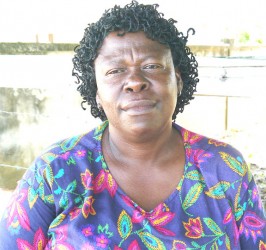
Carol said residents used to play a lot of cricket in the village but the spot has been taken over by bushes. She was concerned that a plot of land has been “earmarked for a playground, located behind the second street, on the northern side of the public road. But for some reason, residents are claiming the land as their bona fide property.” She hopes that “residents would co-operate and assist to clean the place up so the young people can utilise it. That would help them to stop being idle and stop doing crazy things.”
According to Carol, the Joesy estate was owned first by “the Nedds and the Londons, but they sold it.” She pointed out too that “No 11 is annexed to No 10 on the southern side of the road. No 10 should have been annexed to No 11 on the northern side to claim back our part of land.” She explained, however, that, “The old people died and they left no trace, no record or we could have fight for it. Actually, both villages, as well as No 7 were owned by one person, a woman named Cyra Barclay-Alves.”
Her late father joined the army in 1975 at the opening of the Guyana National Service where he was seconded. He retired as a Warrant Officer, Class One. He was also a part of the first great march from Kimbia to Georgetown. In addition, he also was in the City Constabulary, at one point, and then Troopers Security Services followed by COPS Security before “hanging up his gloves.”
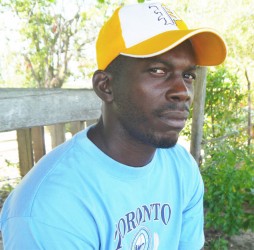
An elderly resident, William Britton, 77, was returning home from the seaside where he had gone to take his cows to graze. He said proudly that he rears livestock and plants a kitchen garden because he likes to keep active. He feels good when he is occupied. Age does not keep him back, he said. “You see, you have to exercise; you can’t sit down.”
In his younger days William also worked hard, cutting cane and working at the railway line and on road construction. He also made time to plant his kitchen garden.
He observed that “the young people now are not interested in farming. They are only smoking and getting into trouble…” He said that “long ago we used to have to go to the backdam to take lunch for we father and we would assist him to weed and so.”
He remembered that there was a pond at the back of the village where residents could see a lot of fish. The funny thing is, he said, no matter how many times they threw their cast-nets they would not catch any fish. The pond, referred to as a ‘Dutch’ pond or ‘Sistan’ pond, can still be seen in the village. It now has just has a little water and has been taken over by vegetation.
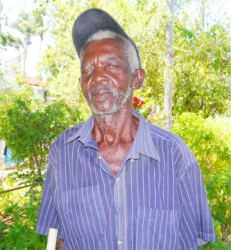
Julius Nurse, a cane-harvester at the Blairmont Estate had just left his home and was awaiting transportation to go to Bath Settlement, three villages away. A former representative of the Guyana Agricultural Workers’ Union, he has been working for years at the estate and said the sugar industry “give me all that I achieved…” He likes his job but said “it can be stressful sometimes because everything don’t always go right and when you turn up for work there
is a strike.”
His normal routine would be to wake up early in the morning to catch the truck at 4 am to start working. The good thing, he said is that he gets home early and would “relax a bit” before starting to work in his kitchen garden. He also used to rear livestock.
Ramesh Molaha, 42, a fisherman owns two fishing boats and would sometimes go out in the deep and catch trout, snapper, mullet and other big fish. He has “all types of seines that can go deep or right in the corner, anywhere.” Ramesh, who started to go out to sea with his relatives during school holidays when he was just nine years old, has been in the fishing business for the past 25 years. He started fishing with a cast-net as a hobby.
His wife, Lalita would walk around in the community and sell the fish or would take them to the market at Rosignol on Saturdays.
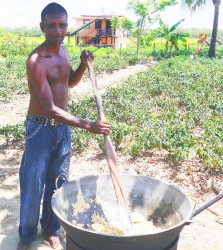
He was not able to go out at sea recently because “the corner would have mud water… And out in the deep the water is too rough and it is hard to pull in the seine. ”
He does not depend on the fish business alone and works as a part-time cane-harvester at the Blairmont Estate. His wife also assists him to plant sweet peppers. “We can’t depend on one thing now because we have a lot of bills to pay,” he said. Besides, he now has to take care of his son, Harriram ‘Rohan’ Molaha, 21, his 18-year-old daughter, Meena Molaha and her husband, Dhanraj Manoj, 20, along with their three-month-old baby.
Meena was six months pregnant when a teenage drunk driver ran her and the two others over with a car. She and her husband suffered broken legs and had to undergo surgery while her brother sustained internal injuries. She is still unable to walk and she does not have a wheelchair, so her father has to lift her around. Her husband moves about with a pair of crutches. The couple spend most of their day sitting on a mattress on the porch.
Recounting that horrible ordeal on September 2, 2012, Meena said they were at a wedding house at No 9 Village when she heard her brother and the teen arguing. They did not know him but later learnt that he belonged to Canje. She said they wanted peace so they asked her brother to go home with them and he did. They were walking along the No 9 road when the teenager came from behind and slammed them. They all fell to the ground and the driver reversed the car in an apparent attempt to run them over again but he crashed into a tree stump.
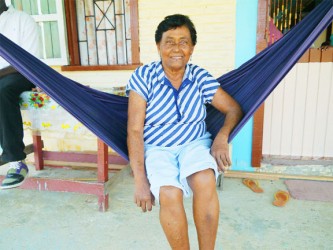
“We din know the boy had a car or we din expect anybody to come and hurt us because we didn’t do anything…,” Dhanraj lamented.
eyewitnesses assisted to take them to the Fort Wellington Hospital where they were treated and transferred to the Georgetown Public Hospital. They also apprehended the driver who was subsequently charged.
Before the tragedy, Manoj, who is from Dochfour on the East Coast Demerara, used to do farming and weed yards for persons for his livelihood. Now he is frustrated that he is unable to earn an income and has to be “one place all the time.”





